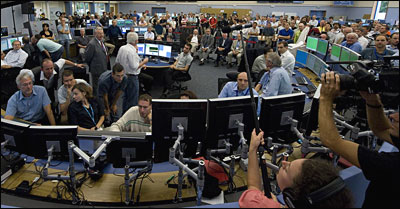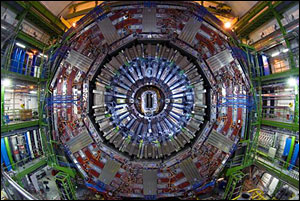
Collider Beams Up at CERN
After 20-plus years of planning, billions of dollars, lawsuits, and even death threats, the first beam of protons in the Large Hadron Collider (LHC) particle accelerator was successfully steered around a 17-mile racetrack at nearly the speed of light this morning, ushering in what is expected to be a new era of scientific discovery.
"It's a fantastic moment," said LHC project leader Lyn Evans, "We can now look forward to a new era of understanding about the origins and evolution of the universe."
The LHC is located deep underground at the CERN (European Organization for Nuclear Research) laboratory near Geneva, Switzerland, and staddles the Swiss and French borders. It cost more than $8 billion to build.

The media and members of the global physics community gather Sept. 10 at the CERN Control Centre for the LHC's First Beam Day. (Photographs: Maximilien Brice Copyright CERN)
An estimated 10,000 people from 60 countries have helped design and build the accelerator and its massive particle detectors, including more than 1700 scientists, engineers, students and technicians from 94 US universities and laboratories supported by DoE's Office of Science and NSF, which invested a total $531 million in the construction of the accelerator and its detectors.
"As the largest and most powerful particle accelerator on Earth, the LHC represents a monumental technical achievement," said US Department of Energy Undersecretary for Science Raymond L. Orbach. "I congratulate the world's scientists and engineers who have made contributions to the construction of the accelerator for reaching this milestone. We now eagerly await the results that will emerge from operation of this extraordinary machine."
The first circulating beam is a major accomplishment on the way to the ultimate goal: high-energy beams colliding in the centers of the LHC's particle detectors. Beyond revealing a new world of unknown particles, the LHC experiments could explain why those particles exist and behave as they do. They could reveal the origins of mass, shed light on dark matter, uncover hidden symmetries of the universe and possibly find extra dimensions of space.
"The LHC is a discovery machine," said CERN Director General Robert Aymar, "Its research program has the potential to change our view of the universe profoundly, continuing a tradition of human curiosity that's as old as mankind itself."
Once colliding beams have been established, there will be a period of measurement and calibration for the LHC’s four major experiments, and new results could start to appear in around a year.

The CMS Detector, one of the Large Hadron Collider's six experiments. The CMS experiment uses a general-purpose detector to investigate a wide range of physics, including the search for the Higgs boson, extra dimensions, and particles that could make up dark matter. The CMS detector is built around a huge solenoid magnet.
Experiments at the LHC will allow physicists to complete a journey that started with Newton's description of gravity. Gravity acts on mass, but so far science is unable to explain the mechanism that generates mass. Experiments at the LHC will provide the answer. LHC experiments will also try to probe the mysterious dark matter of the universe -- visible matter seems to account for just 5 percent of what must exist, while about a quarter is believed to be dark matter. They will investigate the reason for nature's preference for matter over antimatter, and they will probe matter as it existed at the very beginning of time.
Concerns across the world that it will turn out to be a "doomsday" device, generating universe-swallowing massive black holes, were dismissed as unfounded by numerous safety reports conducted on the LHC and by physicists such as Stephen Hawking. Lawsuits have been filed to halt the project and death threats were received by some scientists involved with the LHC (See Threats Won't Stop Collider).
"The LHC safety review has shown that the LHC is perfectly safe," said Jos Engelen, CERN's chief scientific officer. "It points out that nature has already conducted the equivalent of about a hundred-thousand LHC experimental programs on Earth -- and the planet still exists."
"Each collision of a pair of protons in the LHC will release an amount of energy comparable to that of two colliding mosquitoes, so any black hole produced would be much smaller than those known to astrophysicists," the group wrote. They conclude that such microscopic black holes could not grow dangerously.
Starting up a major new particle accelerator takes much more than flipping a switch: Thousands of individual elements have to work in harmony, timings have to be synchronized to under a billionth of a second, and beams finer than a human hair have to be brought into head-on collision. Scientists have completed the first two steps, and, over the next few weeks, as the LHC’s operators gain experience and confidence with the new machine, the machine’s acceleration systems will be brought into play, and the beams will be brought into collision to allow the research program to begin.
For more information, visit: www.cern.ch
Published: September 2008